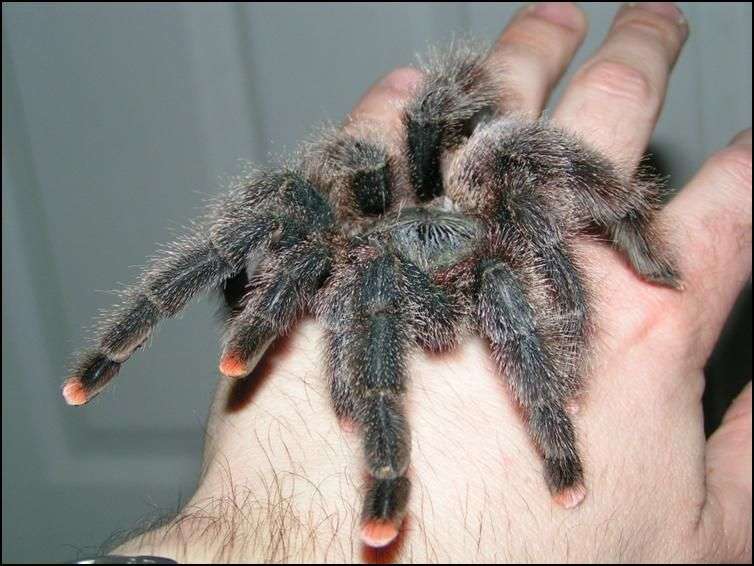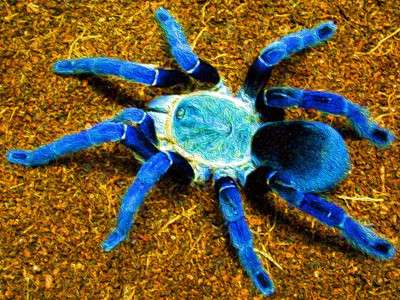
The pinktoe tarantula, a species of New World tarantula in the family Theraphosidae, is distinguished by its recognizable pink feet. The pink toe tarantula can be found on various Caribbean islands and in northern South America. It is an arboreal species that hunts, forages, and uses ambushes as among its primary techniques of prey capture. It has urticating hairs it uses to defend itself and relatively little venom compared to other New World tarantulas. The pink toe tarantula has become more and more well-liked among owners of exotic pets in recent years.
The word avicularia, which means “small bird,” comes from the Latin words avicula, which means “little bird,” and the suffix -aria, which comes from the Latin word arius, which means “pertaining to.” Species belonging to the genus are frequently referred to collectively as “bird spiders” or “bird-eating spiders.”
Appearance
- Pinktoe tarantulas exhibit sexual dimorphism, like the majority of spiders, with females being somewhat larger than males in size.
- Males typically have a leg breadth of about 3.5 inches, whilst females typically have one about 4.75 inches.
- The biggest specimens, however, can reach lengths of up to 6 inches. They have eight legs, two pedipalps (grasping appendages), and two chelicerae (large, deadly fangs).
- With the exception of their dark-colored feet, pink toe tarantulas look mostly pinkish when they are young.
- When they reach adulthood, their color changes, with the body turning dark and the feet appearing pink. Adult body hair is mostly dark brown or black, but it can occasionally have an iridescent green sheen.

Behavior
Pink toe tarantulas are often solitary animals. Although they may occasionally coexist close by, this increases the risk that they may cannibalize one another. Arboreal pink toe tarantulas spend the most of their lives in trees. They sleep throughout the day and come out at night to hunt and search for food, just like other tarantulas. When threatened, they might adopt a protective stance or hurl feces in the direction of the danger. They have urticating hairs, but unlike other New World tarantulas, they are unable to kick them. They can, however, leap short distances, especially when they are young, unlike many other tarantulas. When startled or fleeing from predators, they usually leap.
Habitat
Being an arboreal species, the pink toe tarantula spends the most of its time on the ground among trees. They are primarily found in temperate and tropical woods, as well as grasslands. Pinktoe tarantulas create nests and tunnels, occasionally gathering adjacent trash to do so.
Locations
Pinktoe tarantulas can be found all across South America and the Caribbean, as suggested by their family name (New World). They are present in Brazil, Bolivia, Peru, Venezuela, and Peru. They typically reside in temperate or tropical forests, as well as grasslands. They need access to trees and waters because they are an arboreal species.
Diet
Pink toe tarantulas are carnivores, much as all other tarantulas. Insects including grasshoppers, moths, beetles, and crickets make up the majority of their diet. Having said that, they will consume just about everything they can capture. Small tree frogs and lizards are among them, even though vertebrates typically only make up a small portion of their diets.
Life Cycle and Reproduction
Pink toe tarantulas breed once every year on average. When well-fed, females are more open to mating; when hungry, they may cannibalize males. Additionally, females usually only mate if they have had a molt within the last six months. The duration of mating might range from a few minutes to several hours. The male will use his pedipalps to grasp the female during mating.
Pinktoe tarantulas lay eggs, just like the majority of spiders. The spiderlings hatch after a 7-week gestation period in the eggs. Pink toe tarantulas have dark-colored toes and a mainly pink appearance as youngsters. Before they finally acquire the distinctive dark-colored body and pink toes of an adult, they must undergo multiple molts in which they lose their exoskeleton.
Pinktoe tarantulas typically live 6 to 9 years for females and only 2 to 3 years for males. However, under the correct circumstances, some species can survive up to 10 years in captivity.
Keeping as Pet
How should a pink toe tarantula be cared for?
Because pink toes thrive in humid environments in nature, it’s critical to keep the humidity in your spider’s habitat between 65 and 75 percent. In fact, one of the most challenging aspects of owning a pink toe tarantula is maintaining a high humidity level.
Table





